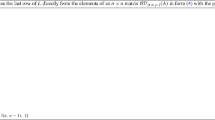Abstract
A nonsingular matrix is called almost strictly totally positive when all its minors are nonnegative and, furthermore, these minors are strictly positive if and only if their diagonal entries are strictly positive. Almost strictly totally positive matrices are useful in Approximation Theory and Computer Aided Geometric Design to generate bases of functions with good shape preserving properties. In this paper we give an algorithmic characterization of these matrices. Moreover, we provide a determinantal characterization of them in terms of the positivity of a very reduced number of their minors and also in terms of their factorizations.
Similar content being viewed by others
References
T. Ando, Totally positive matrices, Lin. Alg. Appl. 90 (1986) 165–219.
J.M. Carnicer and J.M. Peña, Shape preserving representations and optimality of the Bernstein basis, Adv. Comp. Math. 1 (1993) 173–196.
J.M. Carnicer and J.M. Peña, Least supported bases and local linear independence, Numer. Math. 67 (1994) 289–301.
J.M. Carnicer and J.M. Peña, Spaces with almost strictly totally positive bases, Math. Nachr. 169 (1994) 69–79.
C. de Boor, Total positivity of the spline collocation matrix, Indiana Univ. J. Math. 25 (1976) 541–551.
C. de Boor and A. Pinkus, The approximation of a totally positive band matrix by a strictly positive one, Lin. Alg. Appl. 42 (1982) 81–98.
C. Cryer, TheLU-factorization of totally positive matrices, Lin. Alg. Appl. 7 (1973) 83–92.
M. Gasca, C.A. Micchelli and J.M. Peña, Almost strictly totally positive matrices, Numer. Algor. 2 (1992) 225–236.
M. Gasca and J.M. Peña, Total positivity and Neville elimination, Lin. Alg. Appl. 165 (1992) 25–44.
M. Gasca and J.M. Peña, Total positivity, QR factorization and Neville elimination, SIAM J. Matrix Anal. Appl. 14 (1993) 1132–1140.
M. Gasca and J.M. Peña, A matricial description of Neville elimination with applications to total positivity, Lin. Alg. Appl. 202 (1994) 33–54.
M. Gasca and J.M. Peña, Corner cutting algorithms and totally positive matrices, in:Curves and Surfaces in Geometric Design, eds. P.J. Laurent, A. Le Méhauté and L.L. Schumaker, (AKPeters, Boston, 1994) pp. 177–184.
T.N.T. Goodman and C.A. Micchelli, Corner cutting algorithms for the Bézier representation of free forms, Lin. Alg. Appl. 99 (1988) 225–252.
S. Karlin,Total positivity, Vol. 1 (Stanford University Press, CA, 1968).
J.H.B. Kempermann, A Hurwitz matrix is totally positive, SIAM J. Math. Anal. 13 (1982) 331–341.
Author information
Authors and Affiliations
Additional information
Communicated by C.A. Micchelli
Both authors were partially supported by the DGICYT Spain Research Grant PB93-0310
Rights and permissions
About this article
Cite this article
Gasca, M., Peña, J.M. On the characterization of almost strictly totally positive matrices. Adv Comput Math 3, 239–250 (1995). https://doi.org/10.1007/BF02432001
Received:
Revised:
Published:
Issue Date:
DOI: https://doi.org/10.1007/BF02432001




